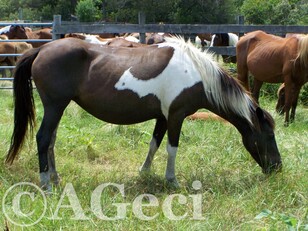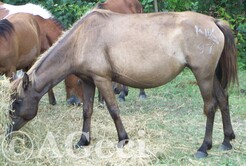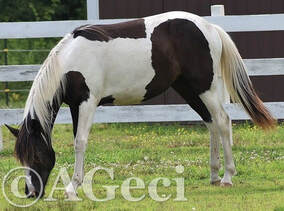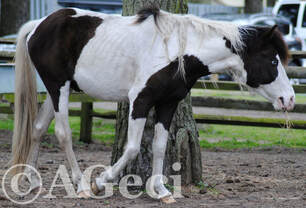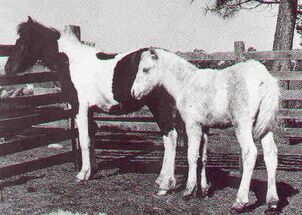Smoky black is one copy of the cream dilution (CR) on black. Black+Cream=Smoky Black.
Cream does not dilute black so it does not change the black coat visually. The pony usually appears to be a normal looking black, but it is actually carrying cream unseen. Cream is still a dominant so it can't skip generations. But you just can't see that it's there. Smoky blacks produce cream dilute foals at the same rate as buckskin and palomino, statistically 50%. Smoky blacks have dark skin and eyes.
Cream does not dilute black so it does not change the black coat visually. The pony usually appears to be a normal looking black, but it is actually carrying cream unseen. Cream is still a dominant so it can't skip generations. But you just can't see that it's there. Smoky blacks produce cream dilute foals at the same rate as buckskin and palomino, statistically 50%. Smoky blacks have dark skin and eyes.
Some smoky blacks do not look like a completely normal black. They may look a bit off colored or fade very badly in the sun. But just as many don't look any different than a regular black pony.
Due to smoky blacks often being visually indistinguishable from regular black it is often not known that a pony is a smoky black until it has been tested for cream or produces a palomino/buckskin/double dilute foal. In the absence of testing this is a common way to make the determination. There are several black ponies on Assateague with a cream dilute parent that may be a smoky black. We'll have to wait until they produce enough offspring to find out.
|
Smoky black tobiano. Her dam is a buckskin. She had multiple cream dilute foals with non cream dilute stallions.
Living Legend (Hurricane x Noble Sea Bird) Pedigree |
|
Solid smoky black. She had multiple cream dilute foals with non cream dilute stallions.
Noah's Shadow Pedigree |
|
Smoky black tobiano. Dam is a cremello.
Misty's Audra Rain (Chesapeake Powhattan's Promise x Misty's Icicle) Pedigree |
|
Smoky black tobiano splashed white. Sired a double dilute out of a buckskin.
WH Clear Blue Sky (WH Nightwind x ?) Pedigree |
|
Smoky black tobiano with palomino tobiano foal in 1946.
Phantom Pedigree Photo from the Pictorial Life Story of Misty. |

